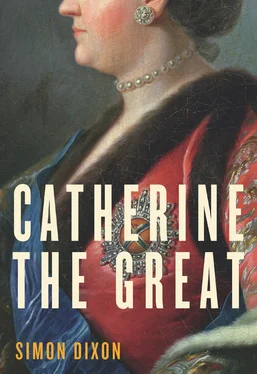Versailles was equally inspirational in matters of Court culture. The Elector of Saxony, Augustus the Strong, was so impressed by his youthful visit to the French Court in the late 1680s that the image of Louis XIV continued to fascinate him even from the grave. Aspiring to resemble his idol as precisely as possible at his son’s wedding, Augustus ordered his Parisian agent in 1717 to send a costume doll to Dresden wearing an outfit ‘such as the late King of France wore on great occasions like his wedding’. A drawing would not suffice, Augustus insisted: it had to be a doll. 41Those unable to marvel at Louis XIV’s palace in person avidly collected the illustrated descriptions that the Bourbon kings were eager to see published as a way of propagating French culture. Karl Eugen of Württemberg employed a full-time agent in Paris from 1748, charged solely with sending to Stuttgart all new publications relating to the Court or to palace design. Goethe expressed a widespread contemporary ambivalence about the whole enterprise:
Duke Karl, to whom one must concede a certain grandeur of vision, worked nevertheless to gratify his momentary passions and to act out a series of ever-changing fantasies. But in that he strove for status, show, and effect, he had a particular need for artists. And even when his motives were less than noble, he could not help but further a higher cause. 42
Fauchier-Magnan’s condescension is therefore seriously distorted. Not only does he fail to see the way that most of the smaller German Courts had risen above the drunken rusticity that disfigured some of the earliest attempts to imitate Versailles, he also misses the central political purpose of representational display. Monarchs in early-modern Europe exercised power over their subjects not by keeping them under observation (as the modern state seeks to do), but by directly representing their exalted status through a series of symbolic gestures, clothing, rhetoric and rituals. 43Everything at Versailles was designed to glorify Louis XIV, from the paintings on the ceiling to the clock that made Fame crown his statue with a laurel every time it struck the hour. 44Princes throughout Europe exhausted their revenues to compete. Since there could be no more lavish setting in which to impress their leading subjects and dynastic rivals than a magnificent palace and Court, cultural rivalry between monarchs was intense. ‘For the baroque prince,’ Tim Blanning has rightly insisted, ‘representational display was not self-indulgence, it was his métier .’ 45And as Sophie discovered when she left Stettin for the last time in 1743, it was a métier practised even by such a minor potentate as Prince Christian August of Anhalt-Zerbst.
Dwarfed by their Saxon and Prussian neighbours, the princes of the House of Anhalt were among the poorest and most insignificant in Germany. Since being divided into four tiny principalities in 1603, their lands had ‘been partitioned so much that there has remained little to partition’, as the mature Catherine observed from the throne of the largest territory on earth since the fall of the Roman Empire. 46That did not mean that their Courts were culturally barren. No less a composer than Johann Sebastian Bach was appointed Court Kapellmeister to Prince Leopold of Anhalt-Köthen in 1717. Sandwiched between periods of even more astonishing creativity at Weimar and Leipzig, Bach’s six years in Leopold’s service produced the six Brandenburg Concertos and the first book of the Well-Tempered Clavier (forty-eight preludes and fugues). 47Yet scarcely anyone beyond the area knew anything of his genius at the time. There was nothing unusual about that in the introverted confessional world of Protestant northern Germany. The only prince of Anhalt to make a wider European impact was Sophie’s contemporary, Leopold III Friedrich Franz of Anhalt-Dessau, who created the first English-style landscape garden in eighteenth-century Germany at Wörlitz between 1763 and 1790, complete with islands named after Rousseau and Herder. Designed to symbolise the reconciliation of technical progress with sentimentalist philosophy, the garden boasted a model volcano whose eruptions were intended to represent the transformative power of Enlightened political reform. 48
Although his volcano has long since gone, Franz’s elegant neoclassical architecture still stands as an oasis of civilisation in the desert of decaying chemical plants that disfigure the former East Germany. The House of Anhalt-Zerbst can boast no such living legacy. Whereas the princes of Anhalt-Dessau survived to witness the formation of the Weimar Republic, Sophie’s father’s line came to an end even within her own lifetime at the death of her brother, Friedrich August, in 1793. Since little remains of the castle at Zerbst, it is tempting to suppose that it must have been no more distinguished than the town which surrounded it. In fact, like so many Baroque palaces in Europe, it was a quintessentially cosmopolitan creation of considerable elegance and beauty.
When its Dutch architect Cornelis Ryckwaert died in 1693, the central block planned in 1680–81 was already complete. By 1710, the addition of the west wing by the Swiss stucco-master Giovanni Simonetti provided the prince’s small retinue with all the ceremonial apartments of a Baroque Court in miniature: a central reception room ( Festsaal ), with ceiling paintings on themes from the Iliad and the Aeneid ; a smaller reception room whose ceiling painting glorified the investiture of the first prince of Anhalt in 1212; and a formal dining hall ( Speisesaal ). By the time that Johann Friedrich Friedel completed the east wing in the spirit of Potsdam rococo, between 1744 and 1748, Sophie had already left for Russia, but she would have worshipped in the ornate chapel at the southern end of the west wing, where Francesco Minetti worked with other artists between 1717 and 1718, inspired by motifs from the Zwinger in Dresden, and she would also have been familiar with the tower built over the castle’s main entrance between 1718 and 1722 by Johann Christoph Schütze, who later took charge of construction at the Saxon Court. 49
In such a modest palace, it was neither possible nor necessary to replicate every element of the etiquette practised at Versailles, which had never been the only available model for the smaller German Courts. Many of them—especially though not exclusively the Catholic ones—adopted the ceremonial of the imperial Court at Vienna, where the Habsburgs preserved, in the relatively unpretentious surroundings of the Hofburg, a ritual tradition adopted from Burgundy and Spain in the sixteenth century. Whereas almost everything in the life of the kings of France was a public spectacle—from the moment they rose in the morning ( lever du roi ) to the moment they retired to bed ( coucher )—the Austrian emperors lived in comparative seclusion, appearing in public only for a limited number of formal meals. 50We do not know which ceremonial model was adopted at Zerbst. Neither can we be sure how far the various procedural manuals potentially available to Christian August were translated into everyday practice. 51However, the unusual fact that his private apartments were built alongside those of his wife, rather than being in separate wings or divided by the main staircase, implies a degree of domestication that serves as a reminder that the Courts of early-modern Europe were by no means monolithic. While itinerant medieval princely households had everywhere settled at a permanent dwelling place ( Residenz ) by 1700, the transformation took place in different ways and at different speeds, and even as more or less regular institutions formed around departments responsible for ceremonial, banqueting, the stables and the hunt, Courts remained complex social organisms, following their peripatetic monarchs to a range of summer and winter palaces, sometimes for whole seasons but often for only a few days at a time. 52Even Christian August had his own country seat at Dornburg on the Elbe, not far from Zerbst, where Schütze had worked his magic so that Sophie found the castle ‘not only very well situated, but embellished as much as possible, both inside and out’. 53
Читать дальше












